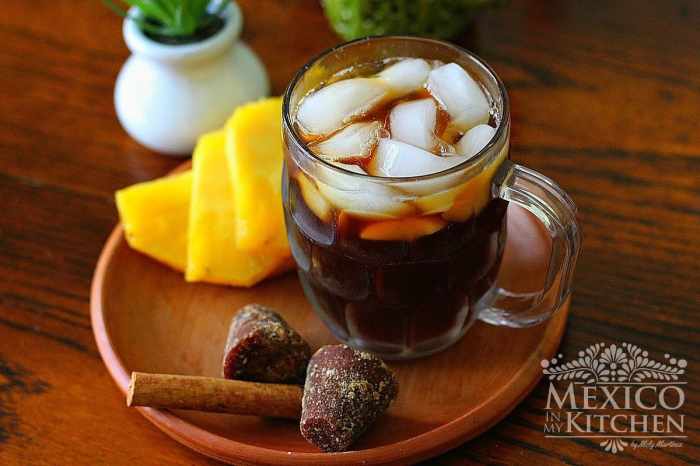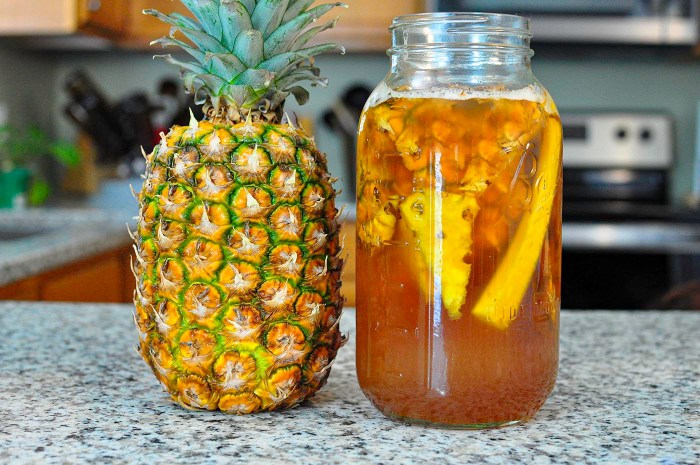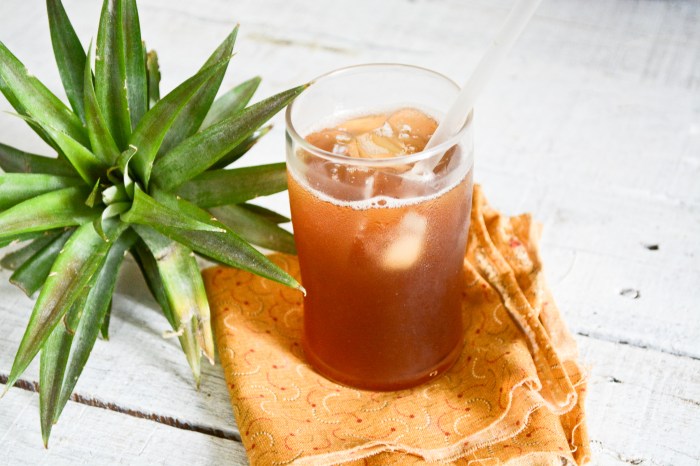Tepache recipe, a traditional Mexican fermented pineapple drink, offers a refreshing and tangy experience. This beverage, deeply rooted in Mexican culture, has a history spanning centuries. From its humble origins to its modern resurgence, tepache continues to captivate taste buds and inspire creativity in kitchens worldwide.
The recipe for tepache is surprisingly simple, relying on the natural fermentation of pineapple, water, sugar, and spices. The process involves letting the ingredients ferment for several days, allowing the flavors to develop and the drink to acquire its characteristic tartness.
This guide delves into the intricacies of tepache, exploring its history, preparation, fermentation, serving suggestions, health benefits, and cultural significance.
Introduction to Tepache

Tepache is a refreshing, fermented beverage that has been enjoyed in Mexico for centuries. It is made by fermenting pineapple peels and rinds with water, sugar, and sometimes spices. The fermentation process creates a slightly sweet, tangy, and bubbly drink that is both delicious and healthy.
History and Origins
Tepache has a rich history that dates back to pre-Hispanic times. The Aztecs and other indigenous cultures in Mexico made a similar fermented drink called “octli” from corn. The word “tepache” comes from the Nahuatl word “tepatl,” which means “drink.” The exact origins of tepache are uncertain, but it is believed to have originated in the southern regions of Mexico, where pineapples are readily available.
The drink was traditionally made by indigenous communities as a way to preserve pineapples and create a refreshing beverage. Tepache played an important role in the social and cultural life of ancient Mesoamerican cultures. It was often served at festivals and ceremonies and was considered a symbol of hospitality.
Popularity and Regional Variations
Tepache is a popular drink in Mexico, and it is enjoyed throughout the country. It is particularly popular in the southern states of Oaxaca, Veracruz, and Chiapas, where pineapples are abundant. Tepache is often enjoyed as a refreshing drink on hot days.
It is also sometimes used as a base for cocktails and other beverages. There are many regional variations of tepache, each with its unique flavor profile. Some recipes include spices such as cinnamon, cloves, and ginger, while others use fruits like mango, papaya, or guava.
- Oaxacan Tepache: This variation is known for its use of piloncillo, a type of unrefined brown sugar, and cinnamon. It has a deep, rich flavor that is both sweet and spicy.
- Veracruz Tepache: Veracruz tepache is often made with a combination of pineapples, mangoes, and guavas. It has a bright, fruity flavor that is perfect for hot weather.
- Chiapas Tepache: Chiapas tepache is known for its use of spices such as cloves, nutmeg, and anise. It has a complex flavor that is both sweet and aromatic.
Ingredients and Preparation
Tepache is a refreshing and tangy fermented beverage that originated in Mexico. Its unique flavor comes from the natural fermentation of pineapple, which results in a slightly sweet and sour drink with a hint of spice. Making tepache is a relatively simple process that requires only a few basic ingredients and some patience.
Key Ingredients
The key ingredients for a basic tepache recipe are:
- Pineapple:The star of the show, pineapple provides the sweetness, acidity, and enzymes necessary for fermentation. Choose a ripe pineapple with a golden yellow skin and a fragrant aroma.
- Piloncillo or brown sugar:This unrefined cane sugar adds sweetness and provides the necessary carbohydrates for the yeast to thrive.
- Water:Water is essential for hydration and helps to create a suitable environment for fermentation.
- Cinnamon sticks:Cinnamon adds warmth and depth to the flavor of tepache.
- Cloves:Cloves contribute a slightly spicy and aromatic note to the drink.
Preparation Steps
Here is a detailed step-by-step guide on how to prepare tepache:
- Prepare the pineapple:Peel and core the pineapple. Cut it into chunks or slices, depending on your preference.
- Combine the ingredients:Place the pineapple chunks in a large jar or container. Add the piloncillo or brown sugar, cinnamon sticks, cloves, and water.
- Stir and cover:Stir the mixture well to dissolve the sugar and distribute the spices. Cover the jar with a breathable cloth or cheesecloth, securing it with a rubber band. This allows for air circulation while preventing dust and insects from entering.
- Ferment:Allow the mixture to ferment at room temperature for 2-3 days. The fermentation process will naturally introduce wild yeast and bacteria, which will break down the sugars and create the characteristic tepache flavor.
- Monitor the fermentation:Check the tepache regularly for signs of fermentation. The liquid should become cloudy and bubbly, and a slight sour aroma will develop. The fermentation process can vary depending on the temperature and the type of yeast present.
- Strain and serve:Once the tepache has reached your desired level of fermentation, strain it through a fine-mesh sieve or cheesecloth to remove the pineapple chunks and spices. Chill the tepache thoroughly before serving.
Variations and Flavor Profiles
Tepache offers a wide range of flavor variations, depending on the ingredients used. Here are some common additions and flavor profiles:
- Spicy Tepache:Adding chili peppers, such as jalapeno or serrano, can create a spicy kick.
- Fruity Tepache:Adding other fruits, such as mango, guava, or papaya, can introduce additional sweetness and flavor complexity.
- Herbal Tepache:Incorporating herbs like mint, basil, or ginger can add refreshing and aromatic notes.
- Citrus Tepache:Adding citrus fruits like lime or orange can enhance the acidity and provide a bright citrus flavor.
Fermentation Process: Tepache Recipe

Tepache’s unique flavor and refreshing fizz come from the magic of fermentation. This process involves the transformation of sugars in the pineapple into alcohol and carbon dioxide, resulting in a delightful, slightly tangy beverage.
Understanding Fermentation, Tepache recipe
Fermentation is a natural process driven by microorganisms, primarily yeast and bacteria. These tiny organisms feed on the sugars present in the pineapple, breaking them down and producing various byproducts, including alcohol and carbon dioxide.
- Yeast: These single-celled fungi are responsible for the alcoholic fermentation, converting sugars into ethanol and carbon dioxide, which contributes to the fizz and slightly alcoholic character of Tepache.
- Bacteria: These microscopic organisms contribute to the sour and tangy flavor profile of Tepache. They convert sugars into lactic acid and other organic acids, adding complexity to the taste.
Fermentation Time and Temperature
The duration and temperature of fermentation significantly impact the final taste and texture of Tepache.
- Optimal Fermentation Time: Typically, Tepache ferments for 2 to 5 days, with the ideal time depending on the desired level of sweetness, tartness, and carbonation. Shorter fermentation times result in a sweeter, less tangy beverage, while longer fermentation times yield a more tart and carbonated drink.
Browse the multiple elements of mango sticky rice recipe to gain a more broad understanding.
- Optimal Fermentation Temperature: A warm environment, around 70-80°F (21-27°C), promotes optimal yeast and bacterial activity, leading to faster fermentation. However, temperatures exceeding 85°F (29°C) can lead to undesirable flavors and potentially harmful bacteria growth.
Monitoring the Fermentation Process
Regular monitoring is crucial to ensure a successful fermentation and a delicious Tepache.
- Visual Inspection: Observe the fermentation activity by looking for bubbles rising to the surface. The presence of bubbles indicates active fermentation, while a lack of bubbles might suggest the fermentation has slowed down or stopped.
- Smell and Taste: As fermentation progresses, the aroma of Tepache will evolve, becoming more tangy and slightly alcoholic. The taste will also change, transitioning from sweet to tart and slightly fizzy.
- Taste Test: Periodically, taste the Tepache to assess the progress of fermentation. If the taste is too sweet, allow the fermentation to continue. If the taste is too tart, you can stop the fermentation by refrigerating the Tepache.
Serving and Enjoyment
Tepache, with its refreshing and slightly tart flavor, is a versatile beverage that can be enjoyed in various ways. Whether you prefer it chilled on a hot day or as a unique addition to your culinary creations, there are plenty of options to explore.
Serving Suggestions
Tepache can be served chilled or at room temperature. It is a perfect beverage for any occasion, from casual gatherings to formal dinners.
- Classic Serving:Tepache is traditionally served in a tall glass with ice. You can also add a slice of pineapple or a sprig of mint for extra flavor and visual appeal.
- Fruity Twist:Experiment with different fruits to enhance the flavor profile of your tepache. Adding a few slices of mango, strawberries, or even a splash of lime juice can create a refreshing and unique taste.
- Spicy Kick:For a more adventurous palate, try adding a pinch of chili powder or a slice of jalapeño to your tepache. The heat complements the sweetness and tartness of the beverage.
- Cocktail Inspiration:Tepache can be used as a base for various cocktails. Mix it with tequila, rum, or even vodka for a unique and flavorful drink.
Flavor Pairings
The slightly sweet and tangy flavor of tepache makes it a perfect pairing for a variety of dishes.
- Mexican Cuisine:Tepache pairs beautifully with traditional Mexican dishes such as tacos, enchiladas, and quesadillas. Its refreshing acidity cuts through the richness of the food.
- Spicy Foods:Tepache’s sweetness and tartness balance the heat of spicy dishes. It is an excellent accompaniment to curries, stir-fries, and other spicy cuisines.
- Cheese and Charcuterie:The slightly acidic nature of tepache makes it a great pairing with cheese and charcuterie boards. The flavors complement each other, creating a delightful contrast.
- Desserts:Tepache can also be used as a base for desserts. Try adding it to ice cream, sorbet, or even cakes for a unique twist.
Storage and Shelf Life
Tepache is best enjoyed fresh, but it can be stored in the refrigerator for up to a week.
To maximize shelf life, store tepache in an airtight container in the refrigerator.
After a week, the flavor of the tepache may start to change, becoming more sour. If you notice any signs of spoilage, such as mold or a foul odor, discard the tepache.
Health Benefits and Nutritional Value

Tepache, a traditional fermented beverage from Mexico, offers a unique blend of flavors and potential health benefits. This refreshing drink, made from fermented pineapple, boasts probiotic properties, essential nutrients, and a delightful tangy taste. Let’s explore the potential health advantages and nutritional value of this ancient beverage.
Probiotic Properties
Probiotics are live microorganisms that, when consumed in adequate amounts, provide health benefits to the host. Tepache’s fermentation process naturally introduces beneficial bacteria, primarily Lactobacillus strains, which contribute to its probiotic properties.
- Improved Digestion:Probiotics in tepache may aid digestion by promoting the growth of beneficial bacteria in the gut, helping to break down food and improve nutrient absorption.
- Enhanced Immune Function:Probiotics have been linked to a stronger immune system. They help maintain the balance of gut bacteria, which plays a crucial role in immune function.
- Reduced Risk of Certain Conditions:Studies suggest that probiotics may help reduce the risk of certain conditions like diarrhea, irritable bowel syndrome (IBS), and even some types of cancer.
Nutritional Content
Tepache is a source of various nutrients, including:
- Vitamins:Tepache contains vitamins B1, B2, B3, and C, which are essential for energy production, cell growth, and immune function.
- Minerals:This fermented beverage is rich in minerals like potassium, magnesium, and manganese, which contribute to bone health, muscle function, and blood sugar regulation.
- Antioxidants:Tepache contains antioxidants, such as bromelain, which is found in pineapple. Antioxidants help protect cells from damage caused by free radicals.
Potential Health Risks
While tepache offers potential health benefits, it’s important to be aware of potential health risks:
- Alcohol Content:Tepache contains a small amount of alcohol due to the fermentation process. The alcohol content can vary depending on the recipe and fermentation time, but it is generally low.
- Allergies:People with pineapple allergies should avoid tepache.
- Sugar Content:Tepache contains natural sugars from the pineapple. Individuals with diabetes or other health conditions should consume it in moderation.
Cultural Significance and Traditions
Tepache, a fermented beverage, holds a special place in Mexican culture, reflecting the country’s rich culinary heritage and vibrant traditions. Beyond its refreshing taste, Tepache is deeply intertwined with Mexican celebrations, social gatherings, and everyday life, making it an integral part of the nation’s cultural fabric.
Tepache in Mexican Culture
Tepache has a long and cherished history in Mexico, dating back to pre-Hispanic times. The beverage was enjoyed by the Aztec civilization, who used it for various purposes, including religious ceremonies and everyday consumption. In modern Mexico, Tepache remains a beloved drink, particularly in rural communities and among those who appreciate traditional Mexican cuisine.
Tepache is often served at family gatherings, fiestas, and celebrations, where it serves as a refreshing and welcoming drink for guests. It is also a common sight at street food stalls and markets across Mexico, where it is sold alongside other traditional Mexican snacks and treats.
“Tepache is more than just a drink; it’s a symbol of Mexican hospitality and a reminder of our cultural heritage.”
Maria Rodriguez, a Mexican chef and food historian.
Regional Variations and Customs
Tepache is not a monolithic beverage; it exhibits diverse regional variations and customs across Mexico. Each region has its unique recipe and preparation methods, reflecting local ingredients and cultural preferences.
- In the state of Oaxaca, Tepache is often flavored with spices like cinnamon and cloves, giving it a warm and aromatic taste.
- In the Yucatan Peninsula, Tepache is sometimes made with pineapple rinds and piloncillo, a type of unrefined cane sugar, resulting in a sweeter and more intense flavor.
- In the central highlands of Mexico, Tepache is often made with corn husks and piloncillo, creating a slightly earthy and savory flavor profile.
These regional variations demonstrate the adaptability and versatility of Tepache, highlighting its deep integration into Mexican culinary traditions.
Tepache in Contemporary Culture
In recent years, Tepache has experienced a resurgence in popularity, particularly among younger generations who are interested in traditional Mexican cuisine and fermented beverages. The rise of craft brewing and the growing demand for artisanal food and drink have contributed to this revival.
- Modern chefs and mixologists are incorporating Tepache into innovative cocktails and culinary creations, showcasing its unique flavor and versatility.
- Tepache is also gaining popularity as a non-alcoholic beverage, appealing to those seeking healthier and more refreshing alternatives to sugary sodas.
- The increasing availability of Tepache in supermarkets and specialty stores across Mexico and internationally reflects its growing popularity and mainstream appeal.
This renewed interest in Tepache reflects a broader cultural shift towards embracing traditional food and drink, while simultaneously exploring new and innovative ways to enjoy them.
Recipes and Resources
This section delves into the world of Tepache recipes, offering both basic and more elaborate variations. It also provides a list of online resources where you can find further inspiration and explore the vast possibilities of this refreshing beverage.
Basic Tepache Recipe
This straightforward recipe provides the foundation for creating a classic Tepache.
Ingredients:
- 1 pineapple, cored and chopped
- 1 cup piloncillo (Mexican brown sugar) or 1 cup granulated sugar
- 1 cinnamon stick
- 4 cloves
- 2-3 cups water
- 1/2 cup pineapple juice
- 1/4 cup active dry yeast
Instructions:
- In a large jar or container, combine the chopped pineapple, piloncillo or sugar, cinnamon stick, cloves, and water.
- Stir well to dissolve the sugar.
- Add the pineapple juice and yeast.
- Cover the jar with a breathable cloth or paper towel and secure with a rubber band.
- Allow to ferment at room temperature for 2-3 days, or until the desired level of carbonation is reached.
- Strain the Tepache through a fine-mesh sieve to remove solids.
- Chill before serving.
Advanced Tepache Recipes
Explore the diverse flavor profiles of Tepache with these recipes incorporating various ingredients.
Spicy Tepache:
Add a pinch of cayenne pepper or a few slices of jalapeño to the basic recipe for a spicy kick.
Fruity Tepache:Experiment with other fruits like mango, papaya, or guava. Add 1-2 cups of your chosen fruit, chopped, to the basic recipe.
Herbed Tepache:Infuse your Tepache with herbs like mint, basil, or cilantro. Add a handful of your chosen herb to the basic recipe during fermentation.
Online Resources
Discover a wealth of Tepache recipes and information online.
- Food52:This website features a variety of Tepache recipes, including variations with different fruits and spices.
- The Spruce Eats:Explore a range of Tepache recipes, along with tips and techniques for successful fermentation.
- Serious Eats:This website offers a comprehensive guide to making Tepache, covering different fermentation methods and flavor combinations.
Closing Summary

Tepache recipe, a vibrant testament to the ingenuity of Mexican cuisine, invites you to embark on a culinary adventure. Whether you are a seasoned fermenter or a curious beginner, this drink offers a gateway to a world of flavors and traditions.
So, gather your ingredients, embrace the process of fermentation, and savor the unique and refreshing taste of tepache.
